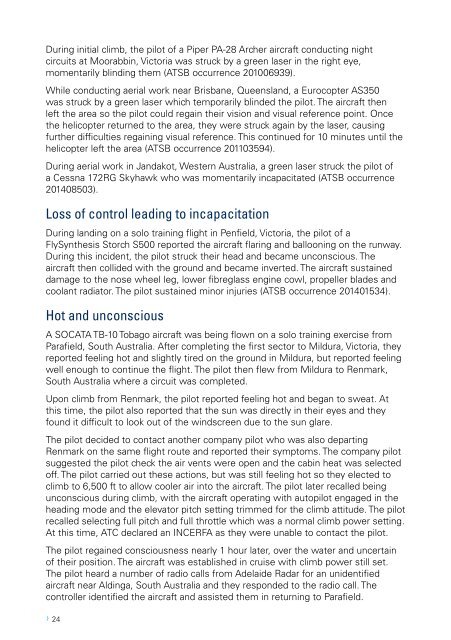Pilot incapacitation occurrences 2010–2014
8rKXy6YKY
8rKXy6YKY
Create successful ePaper yourself
Turn your PDF publications into a flip-book with our unique Google optimized e-Paper software.
During initial climb, the pilot of a Piper PA-28 Archer aircraft conducting night<br />
circuits at Moorabbin, Victoria was struck by a green laser in the right eye,<br />
momentarily blinding them (ATSB occurrence 201006939).<br />
While conducting aerial work near Brisbane, Queensland, a Eurocopter AS350<br />
was struck by a green laser which temporarily blinded the pilot. The aircraft then<br />
left the area so the pilot could regain their vision and visual reference point. Once<br />
the helicopter returned to the area, they were struck again by the laser, causing<br />
further difficulties regaining visual reference. This continued for 10 minutes until the<br />
helicopter left the area (ATSB occurrence 201103594).<br />
During aerial work in Jandakot, Western Australia, a green laser struck the pilot of<br />
a Cessna 172RG Skyhawk who was momentarily incapacitated (ATSB occurrence<br />
201408503).<br />
Loss of control leading to <strong>incapacitation</strong><br />
During landing on a solo training flight in Penfield, Victoria, the pilot of a<br />
FlySynthesis Storch S500 reported the aircraft flaring and ballooning on the runway.<br />
During this incident, the pilot struck their head and became unconscious. The<br />
aircraft then collided with the ground and became inverted. The aircraft sustained<br />
damage to the nose wheel leg, lower fibreglass engine cowl, propeller blades and<br />
coolant radiator. The pilot sustained minor injuries (ATSB occurrence 201401534).<br />
Hot and unconscious<br />
A SOCATA TB-10 Tobago aircraft was being flown on a solo training exercise from<br />
Parafield, South Australia. After completing the first sector to Mildura, Victoria, they<br />
reported feeling hot and slightly tired on the ground in Mildura, but reported feeling<br />
well enough to continue the flight. The pilot then flew from Mildura to Renmark,<br />
South Australia where a circuit was completed.<br />
Upon climb from Renmark, the pilot reported feeling hot and began to sweat. At<br />
this time, the pilot also reported that the sun was directly in their eyes and they<br />
found it difficult to look out of the windscreen due to the sun glare.<br />
The pilot decided to contact another company pilot who was also departing<br />
Renmark on the same flight route and reported their symptoms. The company pilot<br />
suggested the pilot check the air vents were open and the cabin heat was selected<br />
off. The pilot carried out these actions, but was still feeling hot so they elected to<br />
climb to 6,500 ft to allow cooler air into the aircraft. The pilot later recalled being<br />
unconscious during climb, with the aircraft operating with autopilot engaged in the<br />
heading mode and the elevator pitch setting trimmed for the climb attitude. The pilot<br />
recalled selecting full pitch and full throttle which was a normal climb power setting.<br />
At this time, ATC declared an INCERFA as they were unable to contact the pilot.<br />
The pilot regained consciousness nearly 1 hour later, over the water and uncertain<br />
of their position. The aircraft was established in cruise with climb power still set.<br />
The pilot heard a number of radio calls from Adelaide Radar for an unidentified<br />
aircraft near Aldinga, South Australia and they responded to the radio call. The<br />
controller identified the aircraft and assisted them in returning to Parafield.<br />
› 24


